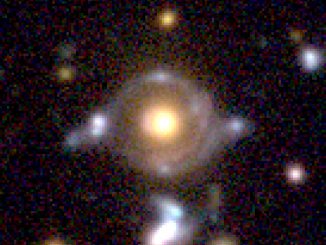The European Space Agency’s Planck satellite discovered a remote cluster of galaxies – PLCK G004.5-19.5 – some five billion light years away by detecting how the cosmic background radiation left over from the big bang was distorted by the cluster’s gravity, a phenomenon known as the Sunyaev-Zel’dovich effect. This Hubble Space Telescope image, released by the European Space Agency, shows the heavily populated galaxy swarm, including an arc-like streak of bluish light from background stars and galaxies that was bent and magnified by the cluster’s combined gravity.
Several foreground stars are visible in the Hubble image, identifiable by cross-like diffraction spikes. But all the other visible objects are galaxies, their light shifted toward the red end of the spectrum by the expansion of space. The image was taken by Hubble’s Advanced Camera for Surveys and the Wide Field Camera 3 as part of a program to identify the brightest distant galaxies to serve as targets for the James Webb Space Telescope, which is scheduled for launch in 2019.




